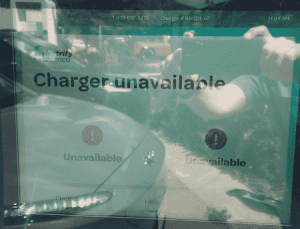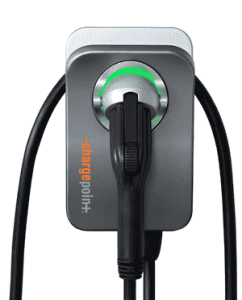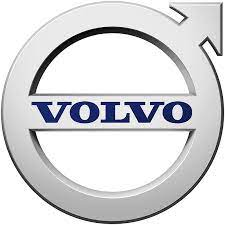 Today I decided to find out how easy or difficult it is to charge up a Hyundai Kona EV at an Electrify America charging station. It was not easy. Continue reading “Trying to charge up a Hyundai Kona at Electrify America”
Today I decided to find out how easy or difficult it is to charge up a Hyundai Kona EV at an Electrify America charging station. It was not easy. Continue reading “Trying to charge up a Hyundai Kona at Electrify America”
What is an EVSE and why do we care?
 What is the device shown in the photograph at right? My quick answer, and you might say the same thing, is that it is “an EV charger”. But my quick answer is wrong. The device shown at right is a mere “EVSE”, not an “EV charger”. This fact, it turns out, explains why a Hyundai Kona (Wikipedia article) charges at a mere 26 miles per hour, when plugged into this 48-amp device, instead of as much as 42 or 43 miles per hour the way some other EV might do. Continue reading “What is an EVSE and why do we care?”
What is the device shown in the photograph at right? My quick answer, and you might say the same thing, is that it is “an EV charger”. But my quick answer is wrong. The device shown at right is a mere “EVSE”, not an “EV charger”. This fact, it turns out, explains why a Hyundai Kona (Wikipedia article) charges at a mere 26 miles per hour, when plugged into this 48-amp device, instead of as much as 42 or 43 miles per hour the way some other EV might do. Continue reading “What is an EVSE and why do we care?”
And now Electrify America decides to join the Tesla charging plug club
 Yesterday Chargepoint, operator of some 48,000 Level 2 charging plugs across the US, said that it plans to join the Tesla charging plug club (blog article). Now, today, Electrify America (“EA”) has announced it will do the same.
Yesterday Chargepoint, operator of some 48,000 Level 2 charging plugs across the US, said that it plans to join the Tesla charging plug club (blog article). Now, today, Electrify America (“EA”) has announced it will do the same.
One reason that the EA announcement is of interest is that EA operates mostly fast DC chargers (as distinguished from Chargepoint which operates mostly mere Level-2 chargers). EA is the second-biggest provider of fast DC chargers in North America, after Tesla.
(See Canonical list of domino clicks for adoption of Tesla charging plugs.)
Two more domino clicks
 We now have two more domino clicks with the by now seemingly inevitable shift in North America to Tesla-style charging plugs. As difficult as one might find it to believe, there is a company in the US that operates more charging stations than Tesla (48,000 charging ports compared with a mere 27,000 or so charging ports from Tesla). And that company, which until now has used J-plugs for its charging stations, has just announced that it will migrate to Tesla-style plugs. That the first of today’s domino clicks.
We now have two more domino clicks with the by now seemingly inevitable shift in North America to Tesla-style charging plugs. As difficult as one might find it to believe, there is a company in the US that operates more charging stations than Tesla (48,000 charging ports compared with a mere 27,000 or so charging ports from Tesla). And that company, which until now has used J-plugs for its charging stations, has just announced that it will migrate to Tesla-style plugs. That the first of today’s domino clicks.
And the Society of Automotive Engineers (“SAE”), the standards-setting body for automobiles in North America, has announced that it will commence a standards-setting process for Tesla-style charging plugs. That’s a second domino click. Continue reading “Two more domino clicks”
Replace all four tires?
 Many owners of an all-wheel-drive vehicle have had it drummed into their heads that if you find the need to replace one tire, the only correct way to proceed is to replace all four tires. But if your vehicle is a “dual motor” EV, that’s wrong. You can get away with replacing just two tires. Continue reading “Replace all four tires?”
Many owners of an all-wheel-drive vehicle have had it drummed into their heads that if you find the need to replace one tire, the only correct way to proceed is to replace all four tires. But if your vehicle is a “dual motor” EV, that’s wrong. You can get away with replacing just two tires. Continue reading “Replace all four tires?”
The Osborne Effect and Tesla supercharging
Four car makers (Ford, General Motors (blog article), Rivian (blog article), and now Volvo (blog article)) have announced that starting about a year from now, their newly manufactured EVs will have a charging port that permits charging at Tesla supercharging stations. This will doubtless trigger the Osborne Effect (Wikipedia article):
The Osborne effect is a social phenomenon of customers canceling or deferring orders for the current, soon-to-be-obsolete product as an unexpected drawback of a company’s announcing a future product prematurely.

The term alludes to the Osborne Computer Corporation, whose second product did not become available until more than a year after it was announced. The company’s subsequent bankruptcy was widely blamed on reduced sales after the announcement.
(See Canonical list of domino clicks for adoption of Tesla charging plugs.)
Volvo announces it will join the Tesla supercharger club
 Volvo has just announced that it will follow Ford and General Motors (blog article) and Rivian (blog article) in making its EVs so that they can plug in directly at Tesla supercharging stations.
Volvo has just announced that it will follow Ford and General Motors (blog article) and Rivian (blog article) in making its EVs so that they can plug in directly at Tesla supercharging stations.
(See Canonical list of domino clicks for adoption of Tesla charging plugs.)
Texas and Washington State – two more domino clicks
And now it looks as though there are two more domino clicks. The state of Texas says it will require that Tesla-style charging plugs be provided at a charging station if it is to receive certain subsidies. And the state of Washington, it seems, plans to require something similar. See this article in The Verge. Continue reading “Texas and Washington State – two more domino clicks”
Rivian – the next domino click for the Tesla standard
 A few weeks ago, Ford and Tesla announced Ford’s plans to start using Tesla-type charging ports on its newly manufactured vehicles (blog article). Shortly thereafter, General Motors and Tesla made a similar announcement. This prompted me to predict a series of domino clicks as other car makers announce similar plans. And indeed we now have another domino click — Rivian. Continue reading “Rivian – the next domino click for the Tesla standard”
A few weeks ago, Ford and Tesla announced Ford’s plans to start using Tesla-type charging ports on its newly manufactured vehicles (blog article). Shortly thereafter, General Motors and Tesla made a similar announcement. This prompted me to predict a series of domino clicks as other car makers announce similar plans. And indeed we now have another domino click — Rivian. Continue reading “Rivian – the next domino click for the Tesla standard”
Lots of Chargepoint Home Flex chargers have lost their green halo
 Update on June 19, 2022: As of a couple of days ago, my two Chargepoint Home Flex chargers have quietly started showing their green halo again, and the left-side LED for wifi is again a steady green light. I believe this is due to the Chargepoint company somehow repairing its broken cloud.
Update on June 19, 2022: As of a couple of days ago, my two Chargepoint Home Flex chargers have quietly started showing their green halo again, and the left-side LED for wifi is again a steady green light. I believe this is due to the Chargepoint company somehow repairing its broken cloud.
There are something like a quarter million Chargepoint Home Flex chargers (photo above right) in service across the US. When the charger is happy, the halo around the charging plug is green such as you see in this photo. But in recent weeks, the halo has been white, for a substantial fraction of the Chargepoint Home Flex chargers that are in service across the US. What does this change of the color of the halo mean? Continue reading “Lots of Chargepoint Home Flex chargers have lost their green halo”